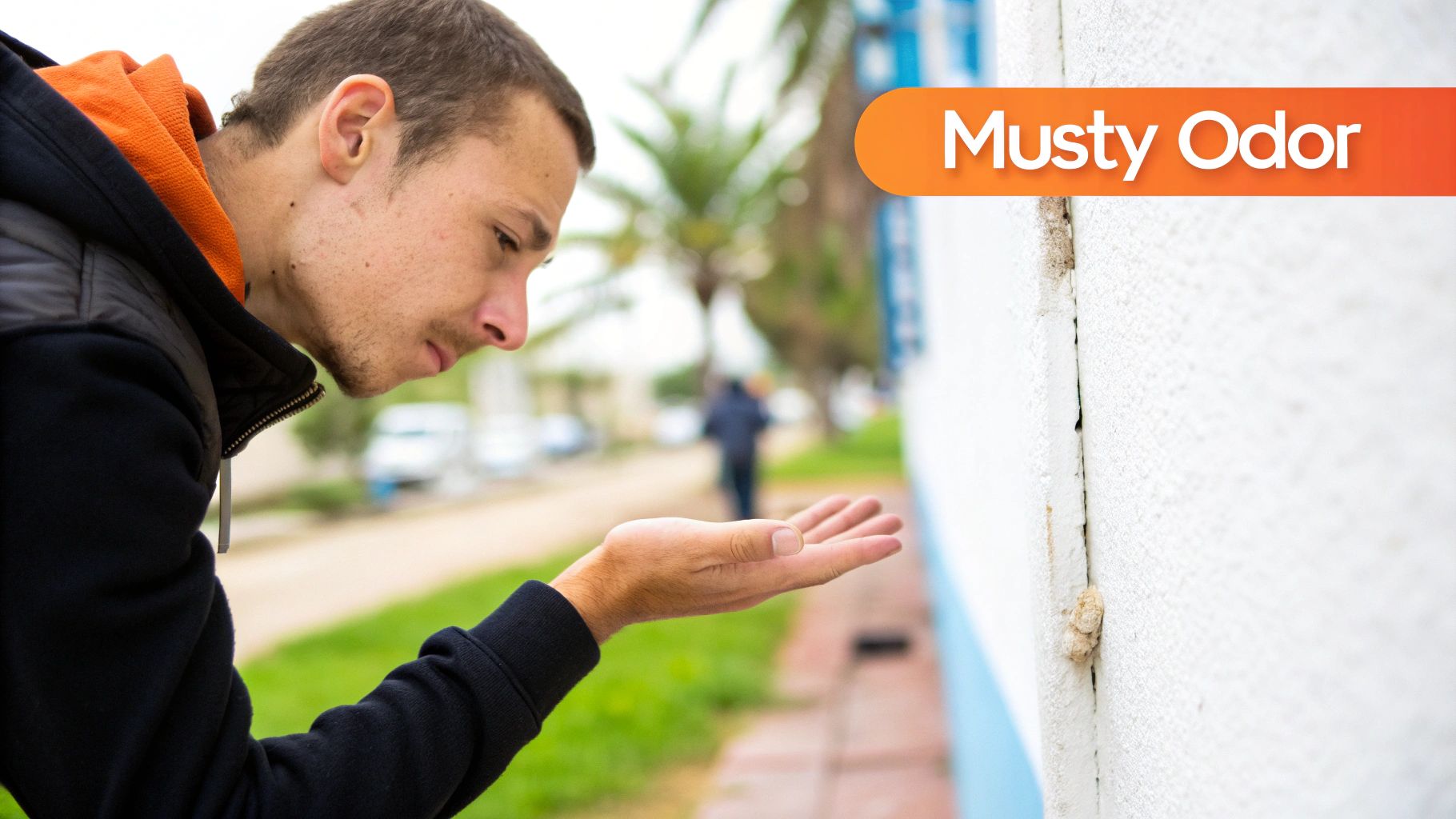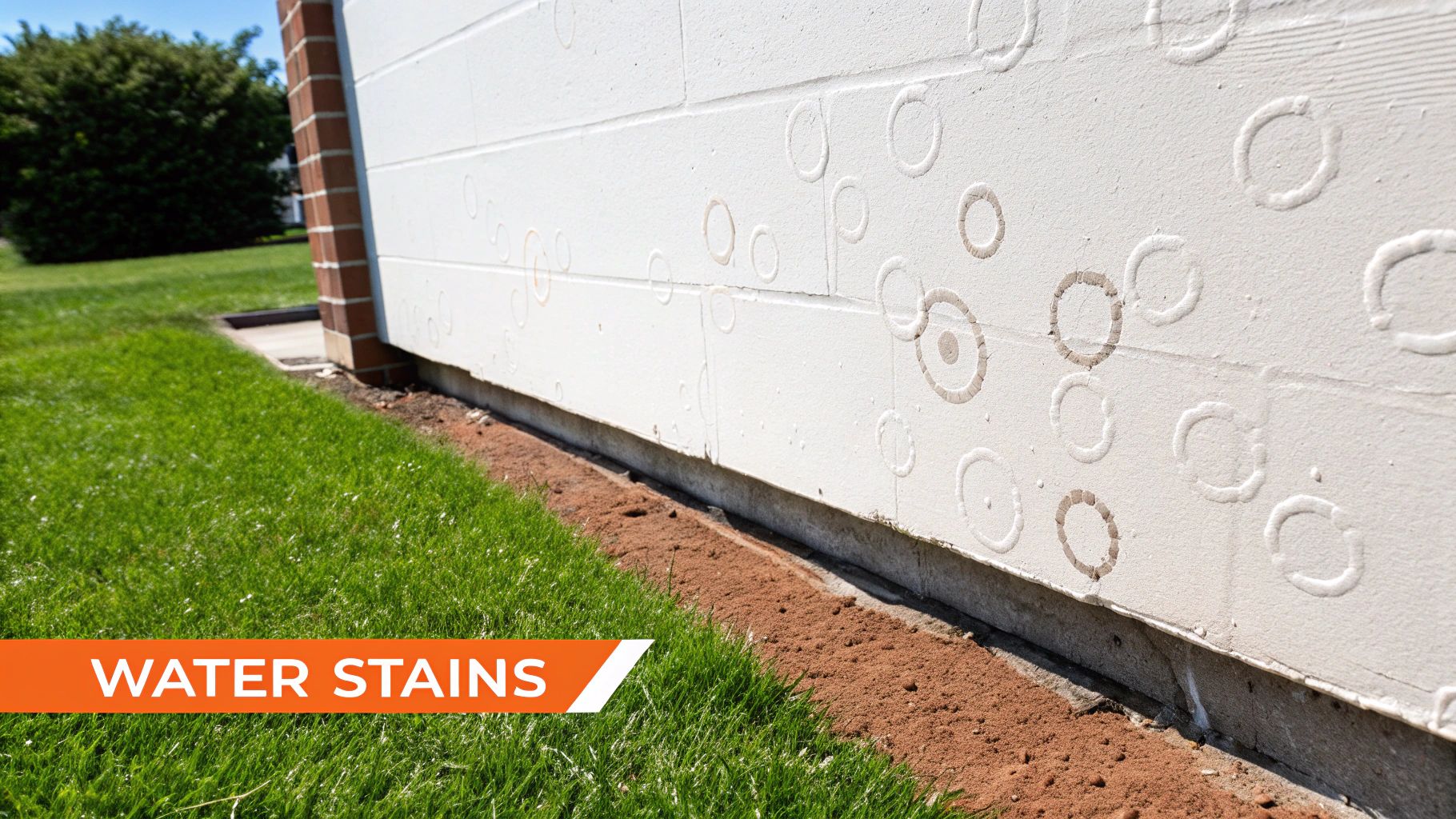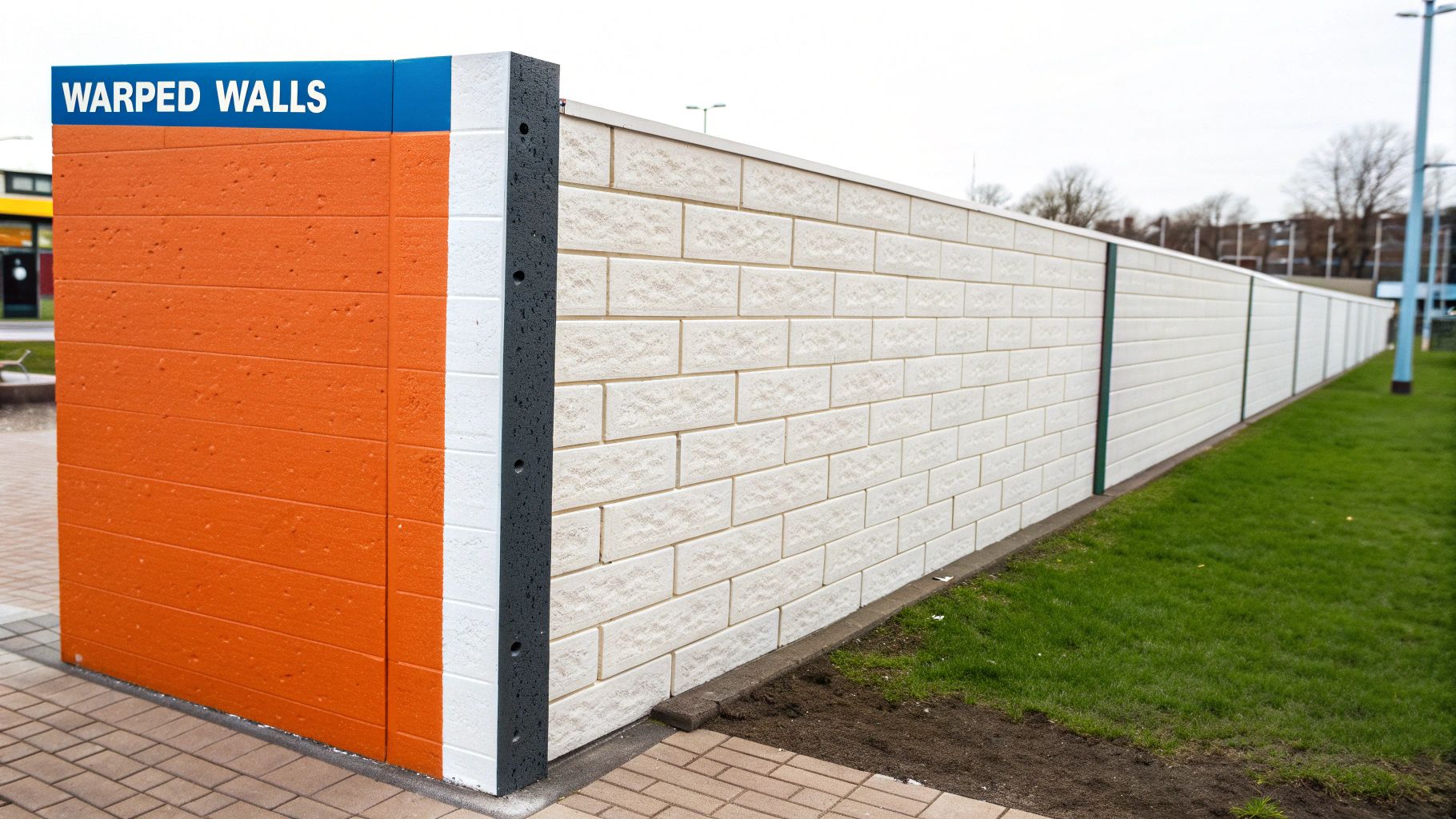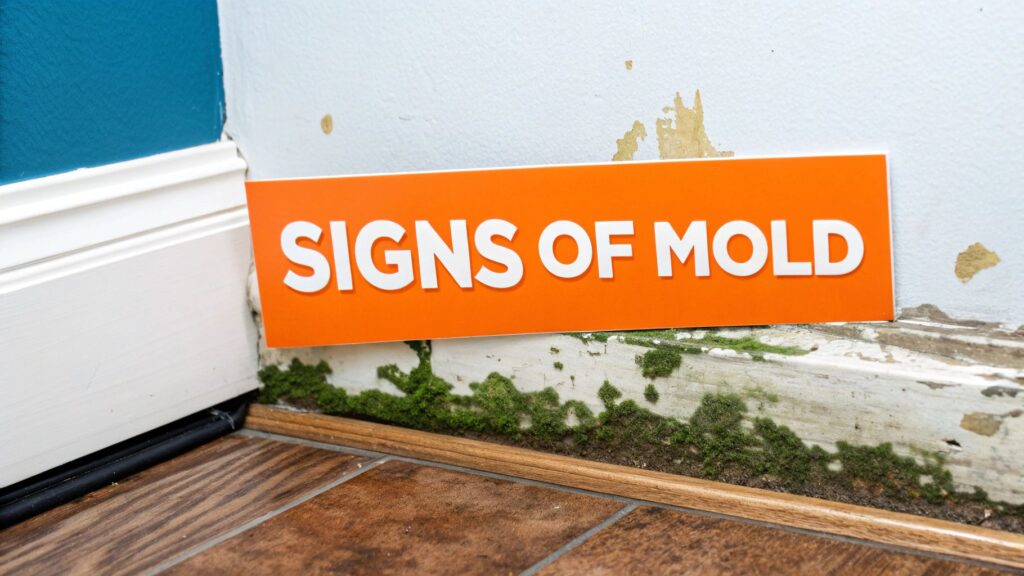In the pristine communities of Orange County, from Newport Beach to Irvine, homeowners prioritize maintaining beautiful, healthy living spaces. Yet, a silent and insidious threat can compromise both your property’s integrity and your family’s well-being: hidden mold growth. When homeowners suspect an issue, the most common concern is the signs of mold in walls, because this is where the problem often begins, out of sight but not without warning.
Moisture from a minor plumbing leak, condensation, or high humidity is all it takes for mold to flourish within 24 to 48 hours. Recognizing these subtle clues early is crucial to preventing a small issue from becoming a costly, complex remediation project that disrupts your life. Ignoring these indicators can lead to significant structural damage and negatively impact your home’s indoor air quality, turning a sanctuary into a source of stress.
This guide, created by the IICRC Master Certified experts at Sparkle Restoration Services, is designed to provide clarity and peace of mind. As a BBB Torch Award Winner for Ethics, our commitment is to empower you with the knowledge needed to protect your investment. We will walk you through the six most critical indicators that mold may be hiding within your walls, helping you protect your property and ensure a safe indoor environment for your family.
1. The Unmistakable Musty or Earthy Odor
Long before you see any visible evidence, your sense of smell can be the most effective early warning system for a hidden mold issue. A persistent musty, damp, or earthy smell inside your home is one of the most reliable initial signs of mold in walls. This distinct aroma isn’t just a sign of dampness; it’s a direct result of the mold’s metabolic process. As mold colonies grow and feed on organic materials like drywall paper or wood studs, they release gases known as microbial volatile organic compounds (MVOCs), which produce that signature scent.

For homeowners in Orange County, where even minor plumbing leaks or window condensation can introduce moisture into wall cavities, this odor is a critical clue. Many describe it as similar to the smell of a damp basement, wet soil after rain, or rotting wood. Ignoring it or attempting to cover it with air fresheners only allows the underlying problem to worsen, potentially leading to more extensive structural damage and compromising your home’s indoor air quality.
How to Investigate a Suspicious Odor
Trusting your nose is the first step. If you detect an unusual, musty scent that doesn’t dissipate with cleaning or airing out the house, it’s time for a more focused investigation.
- Pinpoint the Source: Walk through your home and try to identify where the smell is strongest. Pay close attention to bathrooms, laundry rooms, under sinks, and any areas with a history of water exposure.
- Check Enclosed Spaces: Odors often concentrate in areas with poor air circulation. Open up closets, cabinets, and pantries to see if the smell intensifies. Also, check behind large furniture placed against exterior walls.
- Get a Second Opinion: You can become accustomed to the ambient smells in your own home, a phenomenon known as olfactory fatigue or “nose blindness.” Ask a friend or family member who doesn’t live with you to walk through and confirm if they notice the musty scent.
Expert Insight: The presence of MVOCs indicates active mold growth. Addressing the odor is not just about comfort; it’s about eliminating the source to protect both your property’s value and your family’s health. Professional odor removal on sparklerestoration.com is a key component of comprehensive mold remediation.
If your investigation points to a specific wall or area but you see no visible signs, it’s a strong indicator the mold is growing within the wall cavity. At this stage, it is crucial to consult a certified professional who can use moisture meters and other diagnostic tools to confirm the problem without unnecessary demolition.
2. Visible Discoloration or Staining on Walls
While a musty odor is an early warning, the most definitive visual evidence of a mold problem is the appearance of discoloration or stains on your walls or ceilings. These marks are often the first visible signs of mold in walls and indicate that a colony has established itself. This discoloration can appear as spots, patches, or streaks and may present in various colors, including black, green, brown, yellow, or even white, depending on the mold species and the moisture conditions.

For homeowners in upscale Orange County communities, where maintaining a home’s pristine condition and property value is paramount, these stains are more than a cosmetic issue. They often signify a deeper problem, like a hidden pipe leak or moisture intrusion from the exterior. For instance, you might notice black streaks in the humid corners of a bathroom or green fuzzy patches on a basement wall after heavy rains. These stains can have a fuzzy, slimy, or powdery texture and can expand over time if the underlying moisture source isn’t resolved.
How to Investigate Wall Discoloration
Seeing a suspicious spot on your drywall requires a careful and immediate response. Simply painting over it or cleaning it with a household cleaner will not solve the problem, as the mold colony will likely continue to thrive within the wall cavity.
- Document and Monitor: Take clear, dated photos of the stained area. This helps you track its growth and provides valuable documentation for restoration professionals or insurance claims.
- Assess the Area: Note the location of the stain. Is it near water sources like plumbing, windows, or under the roofline? Does it feel damp or soft to the touch? This context helps identify the potential cause.
- Safety First: If you must inspect the area closely, wear protective gear, including an N95 mask, gloves, and safety goggles, to avoid inhaling mold spores or making direct skin contact. Never try to scrape or disturb the growth without proper containment.
Expert Insight: Visible mold on a wall is often just the “tip of the iceberg.” A small spot on the drywall surface can indicate a much larger, more established colony growing on the paper backing and wood studs inside the wall. Professional assessment is crucial to determine the full scope of the contamination.
If you discover any unexplained discoloration, it’s a clear signal to seek professional help. Certified experts can use non-invasive tools like thermal imaging and moisture meters to assess the extent of the problem behind the wall. Understanding the scope of the issue is the first step in a comprehensive mold remediation plan from sparklerestoration.com that will protect your home’s structural integrity and ensure a healthy living environment.
3. Water Stains or Signs of Water Damage
Visible water stains on your walls or ceilings are one of the most direct and alarming signs of mold in walls. Often appearing as yellow, brown, or copper-colored patches, these stains indicate that water has saturated the drywall, plaster, or paint. This moisture intrusion is the primary catalyst for mold growth, which can begin developing in as little as 24-48 hours. Where there is a water stain, there is a very high probability of a hidden mold colony thriving within the wall cavity.

For high-value homes in Orange County, where maintaining pristine aesthetics and structural integrity is paramount, these stains are a non-negotiable call to action. They can result from a variety of sources, from a slow-leaking pipe behind a bathroom wall to condensation around window frames. Often, visible water damage on walls stems from underlying structural issues. For instance, ceiling stains might point to one of the critical signs you need a new roof. Ignoring these blemishes allows moisture to continue seeping into building materials, creating an ideal breeding ground for mold and jeopardizing your property’s value.
How to Investigate Water Stains
A water stain is a clear symptom of a deeper problem. Even if the area feels dry to the touch, the underlying materials could still harbor dangerous levels of moisture. A methodical investigation is key to understanding the scope of the issue.
- Identify the Source: Trace the stain to its most likely origin. Stains on the ceiling are often from a bathroom or appliance on the floor above, while discoloration near baseboards could indicate a foundation issue or plumbing leak.
- Check for Active Moisture: Use a moisture meter to get a definitive reading of the dampness levels within the wall. This professional tool can confirm if the leak is ongoing and help map the full extent of the water’s spread.
- Document Everything: Before any repairs begin, take clear photos and videos of the stains and any related damage. This documentation is invaluable for insurance claims and ensures a clear record of the home’s condition.
Expert Insight: Painting over a water stain without first resolving the moisture source is one of the most common and costly mistakes a homeowner can make. This cosmetic fix traps moisture, accelerates mold growth, and leads to more extensive and expensive remediation down the line.
The appearance of water stains signifies that your home’s defenses have been breached. Swift and professional intervention is crucial to prevent secondary damage like wood rot and mold proliferation. You can discover more about professional approaches to handling these issues by exploring expert water damage restoration services in Orange County, CA.
4. Peeling, Bubbling, or Cracking Paint and Wallpaper
Changes to the surface of your walls, such as peeling paint, bubbling, or cracking wallpaper, are often dismissed as simple cosmetic wear and tear. However, these issues are frequently among the most telling physical signs of mold in walls. This damage occurs when moisture builds up within the wall cavity, saturating the drywall and compromising the bond between the surface and its covering. The trapped moisture and humidity create pressure that literally pushes the paint or wallpaper away from the wall, while also degrading the adhesive that holds it in place.

For homeowners in Orange County with high-value properties, maintaining impeccable finishes is paramount. Seeing paint bubble near a bathroom shower, wallpaper lift along a basement wall, or exterior paint peel can be alarming. These are not just aesthetic flaws; they are direct indicators of an underlying moisture problem that has likely already created a hospitable environment for mold to thrive just behind the surface. Addressing the visual imperfection without resolving the root cause is a temporary fix that allows hidden mold to continue its destructive path.
How to Investigate Wall Surface Damage
If you notice your paint or wallpaper is failing, a systematic inspection is necessary to determine if moisture and mold are the culprits. A focused approach helps differentiate between a simple adhesion failure and a serious water intrusion issue.
- Look for Patterns: Moisture-related damage is often localized. Check for bubbling paint on bathroom walls near tubs or showers, peeling wallpaper on walls adjacent to plumbing fixtures, or cracked paint on exterior-facing walls where a vapor barrier might be compromised.
- Feel the Surface: Gently press on any bubbling or peeling areas. If the wall feels soft, damp, or spongy, it is a clear sign of significant moisture saturation within the drywall.
- Careful Peeling: If an area is already peeling, you can carefully lift a small, loose section to inspect the drywall and the back of the wallpaper or paint chip. Look for black, green, or white speckled discoloration, which indicates visible mold growth.
Expert Insight: Never simply scrape off damaged paint and apply a new coat. This action, often called “sealing” the mold, is ineffective and hazardous. It traps moisture and allows the mold colony to continue feeding on the organic materials within the wall, leading to more significant structural and air quality problems down the line.
If your investigation reveals dampness or visible discoloration behind the failing surface, it confirms the presence of a moisture issue that requires immediate professional attention. A certified mold remediation specialist can use moisture meters and thermal imaging cameras to map the extent of the water intrusion and formulate a plan for safe and complete removal, ensuring the problem is solved at its source.
5. Warping, Buckling, or Bulging Walls
Beyond discoloration or odors, one of the more alarming signs of mold in walls is a physical change in the wall’s structure. When you notice drywall, plaster, or paneling beginning to warp, buckle, or bulge outward, it’s a clear indication of a significant and prolonged moisture problem. This deformation happens because common wall materials, especially drywall, are highly porous and act like a sponge. As they absorb water, they swell, lose their structural integrity, and expand, creating visible distortions.
For discerning homeowners in Orange County, maintaining the structural and aesthetic perfection of their property is paramount. A bulging wall is not just an eyesore; it signifies that a hidden leak has saturated the wall cavity, creating the perfect breeding ground for extensive mold colonization. This level of damage often points to a serious issue, such as a slow plumbing leak, a compromised building envelope, or chronic condensation, which requires immediate and expert attention to prevent further decay and protect the home’s value.
How to Address Warped or Bulging Walls
Structural changes to your walls should never be ignored. This is a severe symptom that demands a cautious and methodical response to ensure safety and effectively address the root cause.
- Do Not Push or Puncture: Resist the temptation to push on the bulge or create a hole to see what’s inside. A water-logged wall is structurally compromised, and applying pressure could cause it to collapse or result in an uncontrolled release of contaminated water.
- Identify the Moisture Source: The primary goal is to stop the water intrusion. Check nearby plumbing fixtures, appliances, windows, and roofing. A warped wall in a bathroom could stem from a shower leak, while a bulge near a kitchen sink may indicate a dishwasher or pipe failure.
- Document Everything Thoroughly: Before any work begins, take detailed photos and videos of the damage from multiple angles. This documentation is invaluable for insurance claims and provides a clear record for the restoration professionals.
Expert Insight: Warping and bulging are late-stage indicators of water damage, meaning the mold growth within the wall is likely extensive. These situations almost always require the complete removal and replacement of the affected materials, not just a simple repair. A professional assessment is critical to also evaluate potential structural damage to the framing.
A compromised wall structure moves beyond a simple mold issue and becomes a significant structural concern. It’s essential to confirm the integrity of your entire building envelope. Addressing the source is the only way to ensure a lasting solution and maintain the safety and impeccable condition of your Orange County home.
6. Persistent Allergy Symptoms or Respiratory Issues
Sometimes, the most telling signs of mold in walls aren’t physical marks on your property but persistent, unexplained health issues affecting your family. If you or your loved ones experience allergy-like symptoms that worsen at home but seem to improve when you’re away, it could be a direct response to hidden mold. As mold colonies thrive within wall cavities, they release microscopic spores and mycotoxins into the air, which can trigger a significant immune response in sensitive individuals.
For discerning homeowners in Orange County, who prioritize a healthy living environment, understanding this connection is crucial. Symptoms can range from sneezing, chronic coughing, and congestion to more severe issues like skin rashes, debilitating headaches, fatigue, and difficulty breathing. These health effects are particularly important because they may be the only warning sign when no visible mold, staining, or musty odor is present. For instance, a child’s asthma might inexplicably worsen after moving into a home with undetected mold from a past leak.
How to Investigate Health-Related Symptoms
Connecting physical symptoms to an environmental trigger requires careful observation. If you suspect your home is the source of ongoing health issues, a systematic approach can help confirm your suspicions.
- Keep a Symptom Diary: Track when and where symptoms occur. Note if your family’s chronic congestion and headaches seem to clear up during a weekend trip or a vacation, only to return once you are back home. This pattern is a strong indicator of an indoor environmental trigger.
- Consult a Specialist: Discuss your concerns with a physician, particularly one who specializes in environmental medicine or allergies. They can conduct tests to determine if you have a mold allergy and help rule out other potential causes.
- Don’t Dismiss the Symptoms: It’s easy to attribute a persistent cough or runny nose to “just allergies.” However, when these issues defy typical allergy seasons and treatments, it’s time to investigate your home’s environment as a potential root cause.
Expert Insight: The health of your home is directly linked to the health of your family. Vulnerable individuals, such as children, the elderly, and those with compromised immune systems, are especially susceptible to the effects of mold exposure. Addressing potential mold is a proactive step in safeguarding their well-being.
If your investigation suggests a link between your health and your home’s air quality, professional intervention is the next logical step. Technicians can use air quality testing to identify elevated mold spore levels, confirming the presence of a hidden source. Since mold spores are easily circulated, it’s also wise to consider the role your ventilation system plays. Discovering how professional HVAC system cleaning can improve indoor air quality on sparklerestoration.com is an essential part of a comprehensive solution. Additionally, maintaining a clean home is fundamental in reducing airborne allergens. For detailed tips, this guide to cleaning for allergies at home offers valuable strategies.
Signs of Mold in Walls: 6-Point Comparison Guide
| Indicator | Implementation Complexity 🔄 | Resource Requirements ⚡ | Expected Outcomes 📊 | Ideal Use Cases 💡 | Key Advantages ⭐ |
|---|---|---|---|---|---|
| Musty or Earthy Odor | Low – detection via smell only | Minimal – no equipment needed | Early detection of hidden mold; limited info on extent | Initial home checks; quick detection of mold risk | Early warning without special tools; easy to localize |
| Visible Discoloration or Staining | Moderate – visual inspection plus possible testing | Low to moderate – protective gear, testing kits | Clear evidence of mold growth; helps document for action | When mold is suspected or visible; insurance claims | Direct visual confirmation; aids moisture source ID |
| Water Stains or Signs of Damage | Moderate – visual plus moisture tools | Moderate – moisture meters, thermal imaging | Identifies moisture problems that may cause mold | Early moisture detection; insurance documentation | Indicates water intrusion before mold is visible |
| Peeling, Bubbling, or Cracking Paint/Walls | Moderate – visual inspection, possible wall covering removal | Low to moderate – moisture meters potentially needed | Early sign of moisture problems favoring mold growth | Routine home maintenance; pre-renovation checks | Detects moisture before mold appearance; localized |
| Warping, Buckling, or Bulging Walls | High – requires professional evaluation | High – structural inspection and repair resources | Serious structural damage; extensive mold likely | Severe moisture damage assessment; major repairs | Clearly indicates severe damage; prioritizes action |
| Persistent Allergy or Respiratory Issues | Moderate – symptom tracking plus professional health evaluation | Moderate – medical consultations, possible air quality tests | Health impact identification; indirect mold indicator | When occupants have unexplained symptoms | Can alert to hidden mold when no physical signs exist |
Turn Chaos Into Calm: Mold Remediation Steps with Sparkle Restoration
Identifying the subtle yet significant signs of mold in walls is the first, most crucial step toward safeguarding your home’s structural integrity and your family’s well-being. Throughout this guide, we’ve explored the key indicators, moving beyond mere surface-level observations to empower you with the knowledge needed for decisive action. From the unmistakable musty odor signaling hidden microbial growth to the persistent allergy symptoms that disrupt your daily life, each sign tells a story about your home’s indoor environment.
You’ve learned that visible discoloration is not just a cosmetic issue but often the tip of the iceberg, and that seemingly innocent peeling paint or bubbling wallpaper can betray a serious moisture problem lurking beneath the surface. Warped, buckling, or bulging drywall is a clear structural alarm, indicating that moisture has compromised the material’s core. Similarly, persistent water stains are not historical relics; they are active clues pointing to an unresolved leak that could be fueling a hidden mold colony.
From Identification to Lasting Resolution
Mastering the ability to recognize these signs is invaluable. It transforms you from a passive observer into a proactive guardian of your property. Ignoring these warnings can lead to extensive structural damage, diminished property value, and long-term health complications. The peace of mind that comes from knowing your home is a safe, healthy sanctuary is immeasurable, and it all begins with your informed vigilance.
Now that you are equipped with this knowledge, the path forward is clear. The next step is not to guess or attempt a superficial fix, but to seek a professional diagnosis from a certified expert. A true resolution involves more than just cleaning visible spots; it requires identifying and eliminating the root moisture source to prevent recurrence. This is where expertise and advanced technology become non-negotiable. For discerning homeowners in Orange County, from the coastal estates of Newport Beach to the exclusive communities of Irvine, a swift and precise response is paramount.
Your Partner in Excellence and Peace of Mind
At Sparkle Restoration Services, we understand that your home is more than just a structure; it is your sanctuary. As an IICRC Master Certified firm and a distinguished BBB Torch Awards for Ethics Winner, we have been the trusted partner for Southern California’s most discerning property owners since 2002. Our approach is meticulous and comprehensive, utilizing thermal imaging and advanced moisture detection to pinpoint the exact source of the problem. We don’t just remediate mold; we deliver a lasting solution that restores your home and your peace of mind. Let us handle the complexities, so you can return to enjoying the comfort and luxury of your home, secure in the knowledge that it is both beautiful and safe.
Ready to address the signs of mold in your walls with confidence and precision? Contact the experts at Sparkle Restoration Services for a comprehensive, no-obligation consultation and experience our award-winning commitment to turning chaos into calm. Visit our website at Sparkle Restoration Services to see how our seamless, white-glove approach can restore your property to its pristine condition.

